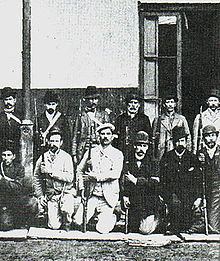Date 1893 | ||
 | ||
Result Revolution crushed by the government. | ||
The Argentine Revolution was a violent uprising by the Radical Civic Union (UCR) against the Government of Argentina. Initially, the UCR leadership attempted to take power by legal means, but this allowed the government to suppress their movement by force.
Contents
First phase: July–August
The Revolution was prepared from Hipólito Yrigoyen and Aristóbulo del Valle unbeknownst to Alem. and Del Valle shared Yrigoyen, against the rest of the radicals, the conviction that UCR should not take the national power through a coup as the failed 1890 constitutional legality to interrupt, but by provincial insurrections, which would lead to the intervention of the provinces and the holding of elections free.
The July 28 revolution started in San Luis Province directed by Teófilo Saa. The revolutionaries quickly took all official dealings and forced the governor to resign as interim governor settled Saa.
The July 30 revolution broke out in Santa Fe. After several days of bloody fighting, finally defeat the provincial government, headed by the governor at the time, Dr. Juan Manuel Cafferata (one of the few members of the National Autonomous Party had assumed power legitimately), and 4 August government takes radical Mariano Candioti. Among the revolutionary leaders was also Lisandro de la Torre.
The revolution in the Buenos Aires by Hipólito Yrigoyen was the best organized and the most powerful. It began at dawn on 30 July simultaneously in 82 cities. The radical army ended up with 8,000 well-armed men, under the direct command of Marcelo T. de Alvear Martin Yrigoyen first and after. Their headquarters was in Temperley, in the vicinity of the city of Buenos Aires. The revolution triumphed everywhere in the province . The August 8 took the capital and installed as interim governor Juan Carlos Belgrano.
When the triumph of the revolution and held, their leaders commit blunders that led to defeat. First, Aristóbulo del Valle, the strongman of the government then refused to give a coup and ousted the president Sáenz Peña, as he claimed Leandro Alem and the bulk of the radical leaders, but had support Yrigoyen who also opposed taking the national power through a coup. Del Valle refused to violate the Constitution and prepared a legal plan, which interfered major provinces and guaranteed free elections. The Senate approved the interventions, but the Chamber of Deputies, and thus defeated the plan of Aristobulo del Valle.
The second blunder came when Hipolito Yrigoyen freed Carlos Pellegrini, one of the key leaders of the autonomismo official, who had been arrested in Haedo by the revolutionaries. Once released, Pellegrini went to the capital and the ruling forces reorganized.
Finally, the third blunder occurred when, inexplicably, Aristóbulo del Valle decided to leave the Government House and go to where he was camped Temperley radical revolutionary army to be present at the time of delivery of the arms. But on August 11 with Aristóbulo del Valle absent from the government house, Pellegrini and Roca astututamente advantage intervention projects that this was sent to Congress, to push through the intervention of the provinces of Buenos Aires, San Luis and Santa Fe, now held by revolutionary governments .
When he learned radicalism of the intervention, the only alternative was that Aristóbulo del Valle gave a coup, ignorant of the law of Congress and left for Buenos Aires with the radical army. Alem is highly requested. But then dominated the legal principles of Aristóbulo del Valle and resigned from the cabinet on August 12, being replaced by roquista Manuel Quintana.
The August 25 the State Committee of the Radical Civic Union decided to surrender their weapons. The revolution had been defeated, apparently.
Second phase: August 14-September
On August 14, 1893, two days after the resignation of Aristóbulo del Valle there was an uprising in Corrientes Province that ousted governor, and was immediately operated on, but lifting persisted. Leandro Alem then considered the revolution far from being defeated, was expecting a massive uprising and decided to start from Rosario. However, Hipólito Yrigoyen felt that the movement was purely emotional and denied the support of the radicalism of the province of Buenos Aires to the second stage of the Revolution of 1893. Remainder of radicalism considered this position Yrigoyen as a betrayal.
The second uprising led by Alem was poorly organized and lacked plan. The 7 September radical commander Bello revolted troops in Tucumán Province and imposed a revolutionary government commanded by Eugenio Mendez. The national government decided to respond firmly and sent a powerful army under Carlos Pellegrini who obtained the surrender of the revolutionary on September 25 .
On 24 September Mariano Candioti with a civil-military army returned to take up arms in the city of Santa Fe and after two days of fighting were defeated . The same day Leandro Alem Rosario became hidden in a cargo ship . The people received him as a hero and was proclaimed President of the Nation in a popular assembly. An immediate, but short of weapons, popular army of 6,000 men was organized. In the port of Rosario, the ship ARA Los Andes Navy, commanding the frigate lieutenant Gerardo Valotta bowed to the revolution and participated in the Combat of El Espinillo where he faced Captain Manuel García Mansilla, so did the torpedo Murature in Tiger, which was destroyed by loyalist troops.
